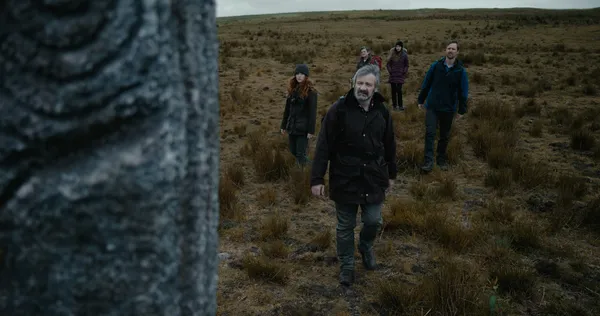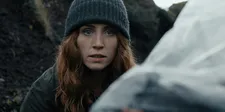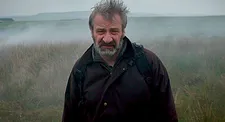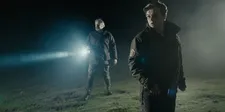 |
| The Moor Photo: Chris Cronin |
There isn’t usually much UK representation at Fantaspoa, which is fair enough, because it is six and a half thousand miles away. This year, however, Chris Cronin’s haunting tale of grief, guilt and desperation, The Moor, will be showing South Americans a side of England that they don’t usually see. It’s the story of Claire, a young woman who travels back to her hometown in the North years after a tragic event in which her friend was abducted, and reconnects with the boy’s father, Bill, who is still obsessively looking for him.
I’m familiar with the country where the film is shot, and congratulate Chris on how effectively he has captured the atmosphere of the place, an important factor in the film’s effectiveness.
 |
| The Moor Photo: Chris Cronin |
“Oh, man,” he says. “You just rely on the natural weather of the North, don't you? That's the thing. If you want a cloudy looking movie, you do that.” He laughs. “I think when people think of the North, they do think of it as a bit grey and grim, but that that area, on a good day, is a beautiful looking place. On a bad day, it looks like a good location for a horror. So we really just tied it into our schedules. If it was a good day, we had a certain scene we could shoot. We’d shoot interiors, then we'd go out and shoot all the exteriors later. It wasn't about trying to make the North look grim, it was just that the story was grim.
“On the moor, it's the air pressure – the weather can change quite rapidly. It actually is a genuine thing. The scenes where we had heavy mist, we'd be shooting another scene and 15 minutes in, the mist would come in, and we’d switch up the scene. So it was really just being receptive to the elements. We were not a big budget film so we couldn't take big lights onto locations, so a lot of it was natural outside. Every location was a real environment in the North, so the authenticity that you experience living or being around there came through, I think.”
I tell him that I really like the way that the lighting in the characters’ houses works, and makes them feel so small and so vulnerable, just on the edge of all that huge darkness.
“One of the nicer things people said is that for a film about the vastness of the moor, it's quite a claustrophobic movie,” he recalls. “That’s something we tapped into with the cinematography as well as the performance of the story. So, yeah, it was very intentional. Horror films can rely on once it's gone dark, it gets scary, and we tried to try to not rely on that too much and to save it for when we really needed it.
“If you talk about claustrophobia, again, there’s not much light, but in the camera framing, too, that found footage ending was quite claustrophobic. There was a lot of things we did. If it was daytime, where it was fully lit, they'd be surrounded by mist or rain. And then if it was night-time, we brought the lights in really tight, so we always had the darkness over their shoulders. And then if were in the daytime, and we didn't have the weather elements, we would bring in the camerawork to make it feel quite claustrophobic.”
Was that atmosphere one of the starting points for the film?
“Oh, totally. Me and the writer [Paul Thomas] grew up in Huddersfield, and we could see the moors over the hillside, even from our school playgrounds. We knew that our parents didn't like them but they didn’t really tell us why because we were little, so we would make up ideas of what it was that was so bad about them in our heads. What we did is when we approached this material, it was more about that. It was like, what was the bogeyman that scared us as kids? Manifested in a mature story. And then obviously the writer went away and did all his research about the murders, the Lindow man in Cheshire, the standing stones in Ilkley, all the way, as far back as he could.
 |
| The Moor Photo: Chris Cronin |
“For thousands of years there have been sacrifices made up there. So we just took that childhood fear of the moor, sprinkled in a bit of parental fear of the real events, and then all of its history. And we made our completely original story there. The moor hills are quite striking if you catch them on a bad day. People who auditioned for the film, before they did the audition, they would go ‘I drive past the moors all the time and it still sends a shiver down my spine.’ It has a elemental presence. Not much work needs to be done with the setting”
There is the echo of the murders there, but there's also something much older. People have, I suggest, probably been keeping their kids away from there for centuries.
“Yeah – not many people talk about that. Obviously the stuff that happened about 65 years ago is the most palpable element in it, but there's been horrible things going on on the moors for centuries.
“What's strange to me is horrible things have happened since, but the events that happened then is still very much the collective trauma of the North. It still resonates quite a lot. I like to think that we didn't exploit it. We used it as a setup – we all know what this felt like – and then we move into completely new territory and focus on survivor’s guilt, the relationship between the father and the daughter, and stuff like that.”
We talk about the initial sequence in the film, which looks at the abduction from Claire’s point of view. It's sensitively handled and we don't see anything very directly, and that seems to speak to me again about the experience of children. Children aren't told exactly what's happening. They just have that sense of danger.
“Yeah. It's weird because it's obviously the children who were the victims. The characters in the opening where you worry something happened, I always called it the parents’ worst nightmare scene. This isn't something kids will watch and go ‘Oh no!’ It's more something a parent will watch. It was always like, ‘How do we start this?’ And I said, ‘I used to have a friend who used to steal sweets from the corner shop.’ How Northern is the corner shop?
“That opening sequence is kind of based on my childhood fantasy of ‘What if this was the wrong decade?’ Obviously our film is set in the Nineties, so it's different – but the innocence we had and the freedom we had as children to just do what we wanted and go out and go shopping...” He trails off. “You know, your mum would send you out for some sweets or whatever. It was just everyday. It was so easy to just take a child, really.”
I really felt that the start could really stand on its own. It didn't even need to be part of a feature because the children are so good, I say, and he agrees.
“It’s set in the summer. It's got a child cast. It's one location, a different type of shooting style so I didn't need as much crew. And yeah, we just treated it as a short film: beginning, middle and end. So it's great that it paid off. I feel like it informs the film quite a lot. That immediacy that that opening creates, it's not just a memory. You get to live it for a minute.
 |
| The Moor Photo: Chris Cronin |
“It was weird because we edited the film before we even shot the opening, but it didn't hit until we put on the opening sequence. In the coffee shop scene with Claire and Bill, you go ‘Oh, that's the same girl from the opening.’ And you can see why there's the reserved trauma and all that stuff.”
It seems to emphasise how immediate it still is to them. Particularly to Bill, since he's trying constantly to recapture that life that he had.
“I think it's even worse for him, probably, finding out that somebody said he was looking for his dad. The fact that even the name dad or father was mentioned in the thing that fooled him into going missing – he's probably still haunted by all of that. So yeah, it's pretty dark.”
He's a really interesting character. He seems to have reached the point where he's tried everything logical that he can do, and so he's more and more irrational in what he's resorting to.
“Me and Paul talked about it a lot because Bill's quite complicated character,” he says. “He's the one who's driving it all forward, and we always saw him as a really capable businessman. He got stuff done, and he saw himself as a provider, all that kind of stuff. The worst thing that could ever happen to a father has happened and usually he’s a hammer and nail kind of guy. Like, ‘Here's a problem, here's a solution, let's do it.’ So he's diving into the realms of séances, and whether he believes or not, he still sees it as a hammer and nail situation. Just, like, ‘Point to an area that you can tell me my boy is at, and I will go to it and dig everywhere.’ He almost switches that part of his brain off that goes ‘Maybe I don't believe in this,’ because it doesn't matter anymore.”
He asks me if I believe in the supernatural, and I respond that I don't, but then again, I wouldn't say that I'm certain of the limits of everything that's natural.
“Yeah, that's fair,” he says. “But you say that to a bunch of people, and they go ‘Nah.’ Then you go ‘Alright, well I'm going to take a Ouija board and go up to this empty house in the woods,’ and they go ‘No way! I’m not going.’ They go ‘Well, there's something.’ Do you know what I mean? And I think Liz is a bit like that. She's like, ‘I have a map, I know the weather, I have the boots, but I don't want to mess with that.’ I think there's Liz there, Bill there, Claire there, and then on the other end, there's Alex and Eleanor, the reverse of everything. So it's nice to see those dynamics play out.”
We talk about how he set up those sequences, and he gives most of the credit to Paul.
“The characters are so well thought out. They're well written, and they're very grounded. I think that's what was very important to us, was to keep them as grounded as possible. So their motivations and intentions in every scene, I think, are pretty vivid. That's what's really interesting about Bill. He is a very practical man, and he still goes along with the supernatural stuff. It makes sense, but it's not in his nature, so what is going on there? And it's like you said, it's the desperation. He's desperate enough to try anything. And Claire's sympathetic and so guilt ridden that she's willing to follow Bill until something actually does happen. The dominoes are set up for me, really. It's just up to me and the actors to knock them down appropriately. So we just stuck to the intentions of the script.”
 |
| The Moor Photo: Chris Cronin |
How did he find that cast?
“David [Edward-Robertson, who plays Bill] I've known for over ten years. He was in one of my first short films [Ante]. He wasn't somebody I was planning to cast, but as we were looking at audition tapes and stuff, I was like, ‘Actually, he's got to the age now where he can probably play this character.’ And I auditioned him, and he did it with flying colours. And then through the casting process and agencies and stuff we found Sophia [La Porta, who plays Claire]. She just really popped on screen. She was in a great show called The Five, one of Harlan Coben's adaptations. She had this thing where she did something bad and was guilt ridden, but we just bled for her still. She was just such a lovely character. So she fit.
“The rest were through the casting process. They all brought a different energy. Sophia is so good. She can switch it on and off, and she's just brilliant that way – where David, he goes to bed with those thoughts and gets up with those thoughts and then at the end of the production just goes...” He mimes a physical collapse. “They all had different processes. It was very challenging, but it was very rewarding.”
We move on to talk about the practical challenges of shooting in such an unforgiving environment.
“We tried to keep close to the roads,” he says. “We barely shot on the moors because they're quite well protected. We worked on private land and we worked on a farm next to the moorland. The interior of the tent was in a warehouse, and what we did was we chopped two tents in half, so when we needed to do full shots we could go a bit further back. So it was a bit of camera trickery in scale. A bit Lord Of The Ringsy.
“It was very minimal crew. We mostly stayed off the moor. A few of us just had to go out and do it. We didn't go that far out. I know that the best locations are three miles in, but it was just never going to be feasible. And you mentioned about how difficult the terrain is. So if you kind of had a football field worth of moorlands, it would take you three times as long to walk in over than it would over a normal football field. It's exhausting. Your legs just disappear randomly at times. It's not the safest environment to work on. So we tried to make sure we had pathways and we didn't stray far.”
Did that affect the mood and help with the performances, that people had that sense of the danger there?
“I think all of it did. I think you're right. I think the subject matter seeps into you eventually. I thought they were angry at me at one point. I thought ‘Everybody seems to be quieter now. Is everybody angry at me?’ And I realised it's because it was week three and we were doing a séance. The room was oppressive. All the interiors, when it's quite an oppressive scene, you can feel it. We had to step outside and eat and cheer up on the moors.”
They’re very proud of the result, he says. I congratulate him on how well it has done at festivals. He admits that he didn’t know which were important when the film began its journey, and is excited when I explain how influential Fantaspoa is. He’s grateful to the Frightfest team for their support of the film, and describes Abertoir’s team as “the coolest people,” but what he’s really looking forward to is the film hitting streaming platforms, so that everybody else will have the chance to see it.





















